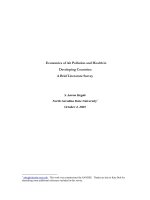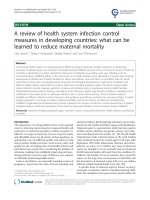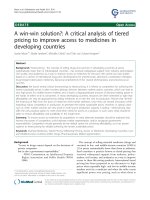Lecture Development economics - Lecture 30: Trade policy in developing countries
Bạn đang xem bản rút gọn của tài liệu. Xem và tải ngay bản đầy đủ của tài liệu tại đây (451.49 KB, 35 trang )
Trade Policy in Developing Countries
Lecture 30
Chapter Organization
•
•
•
•
•
Introduction
Import-Substituting Industrialization
Problems of the Dual Economy
Export-Oriented Industrialization: The East Asi
Summary
Introduction
• There is a great diversity among the
developing countries in terms of their
income per capita.
• How, if at all, is this variation in per capita
income related to variation in trade
policies?
– Do protectionist policies cause economic
backwardness?
• Failure of import-substituting industrialization
• Success of export-oriented industrialization
– Does economic backwardness require
protectionist policies?
• Economic dualism
Introduction
Table 10-1: Update
• See the CIA World Factbook 2004 for
recent data on per capita GDP.
Import-Substituting Industrialization
• From World War II until the 1970s many
developing countries attempted to accelerate
their development by limiting imports of
manufactured goods to foster a
manufacturing sector serving the domestic
market.
• The most important economic argument for
protecting manufacturing industries is the
infant industry argument.
• This argument suggested that trade may be
good for rich countries but bad for poor
countries.
Import-Substituting Industrialization
• The Infant Industry Argument
– It states that developing countries have a
potential comparative advantage in
manufacturing and they can realize that
potential through an initial period of protection.
– It implies that it is a good idea to use tariffs or
import quotas as temporary measures to get
industrialization started.
• Example: The U.S. and Germany had high tariff
rates on manufacturing in the 19th century, while
Japan had extensive import controls until the
1970s.
Import-Substituting Industrialization
• Problems with the Infant Industry
Argument
– It is not always good to try to move today into
the industries that will have a comparative
advantage in the future.
• Example: In the 1980s South Korea became an
exporter of automobiles. At that time it was wellendowed with capital, which is important for
comparative advantage in car manufacturing. In
the 1960s its capital and skilled labor were still very
scarce. Therefore, if the Korean government had
used protection in the 1960s to start a domestic
Import-Substituting Industrialization
• Problems with the Infant Industry
Argument
– Protecting manufacturing does no good
unless the protection itself helps make
industry competitive. Indeed, protection from
foreign competition may take away the
pressure to improve competitiveness.
• Example: Pakistan and India have protected their
heavy manufacturing sectors for decades and
have recently begun to develop significant exports
of light manufactures like textiles, not the heavy
manufactures that they had protected.
Import-Substituting Industrialization
• Problems with the Infant Industry
Argument
– Government intervention becomes needed
only when there exists some market failure.
The infant industry argument for protection
does not identify any market failure that the
protection is meant to address.
– It is implicitly assumed that the capital market
fails to see the bright future in an infant
industry that the government can see. But,
– In the advanced countries at least, private
lenders often sustain infant industries for long
periods of time. So, the better approach in
poor countries may be to fix the capital
Import-Substituting Industrialization
• Market Failure Justifications for Infant
Industry Protection
– Two market failures are identified as reasons
why infant industry protection may be a good
idea:
• Imperfect capital markets justification
– If a developing country does not have a set of financial
institutions that would allow savings from traditional
sectors (such as agriculture) to be used to finance
investment in new sectors (such as manufacturing), then
growth of new industries will be restricted.
• Appropriability argument
– Firms in a new industry generate social benefits for
which they are not compensated (e.g. start-up costs of
adapting technology).
Counterargument
• The market failures—imperfect capital
markets and non-appropriable social benefits
—should be addressed directly, not by tariffs
• In practice, it is difficult to spot the industries
that warrant special treatment. In the end it
comes down to which industry has more
political clout
• Reduction of imports will necessarily reduce
exports
Import-Substituting Industrialization
• Promoting Manufacturing Through
Protection
– Has import-substituting industrialization
promoted economic development?
• Many economists are now harshly critical of the
results of import substitution, arguing that it has
fostered high-cost, inefficient production.
Import-Substituting Industrialization
– Why not encourage both import substitution
and exports?
• A tariff that reduces imports also necessarily
reduces exports.
• Until the 1970s many developing countries were
skeptical about the possibility of exporting
manufactured goods.
• In many cases, import-substituting industrialization
policies dovetailed naturally with existing political
biases.
Import-Substituting Industrialization
Table 102: Exports as a Percentage of National Income, 1999
Import-Substituting Industrialization
• Results of Favoring Manufacturing:
Problems of Import-Substituting
Industrialization
– Many countries that have pursued import
substitution have not shown any signs of
catching up with the advanced countries.
• Example: In India, after 20 years of economic
plans between the early 1950s and the early
1970s, its per capita income was only a few
percent higher than before.
Import-Substituting Industrialization
– Why didn’t import-substituting industrialization
work the way it was supposed to?
• Comparative advantage may be related to
fundamental factors. Protection from foreign
competition will not always help.
• If all that is missing is experience, importsubstituting industrialization may help. But
• If the problem is the lack of skilled labor,
entrepreneurs, managerial competence, and social
organization, then protection will not help.
Import-Substituting Industrialization
– Import-substituting industrialization generated:
• High rates of effective protection
• Inefficient scale of production
• Higher income inequality and unemployment
– By the late 1980s, statistical evidence
appeared to suggest that those countries that
had free trade grew faster on average.
Gradually, the poor countries began to
remove import quotas and reduced tariffs.
Import-Substituting Industrialization
Table 103: Effective Protection of Manufacturing in Some Developing
Countries (percent)
Dualism in poor economies
• So, import-substituting trade policies may
have made some countries poorer
• But it is also possible that certain
distinctive features of poor countries
encouraged their adoption of importsubstituting trade policies
• These distinctive features are collectively
referred to as dualism.
Problems of the Dual Economy
• Most developing countries are characterized
by economic dualism.
– A high-wage, capital-intensive industrial sector
coexists with a low-wage traditional sector.
• Dualism is important for trade policy for two
reasons:
– Dualism is probably a sign of markets working
poorly (market failure case for deviating from free
trade).
– The creation of the dual economy (an economy
that is characterized by economic dualism) has
Problems of the Dual
Economy
• The Symptoms of Dualism
– Development often proceeds unevenly and
results in a dual economy consisting of a
modern sector and a traditional sector.
• The modern sector typically differs from the
traditional sector in that it has:
–
–
–
–
–
Higher value of output per worker
Higher wages
Lower returns to capital
Higher capital intensity
Persistent unemployment (especially in urban areas)
Problems of the Dual Economy
• Dual Labor Markets and Trade Policy
– The symptoms of dualism are clear signs of
an economy that is not working well,
especially in its labor markets.
– Wage differentials argument
• The wage differences between manufacturing and
agriculture is a justification for encouraging
manufacturing at agriculture’s expense, perhaps
with a tariff on imports.
• This argument is formally similar to the argument
for immigration.
Problems of the Dual Economy
Figure 101: The Effect of a Wage Differential
Value of marginal
products, wages
B
WM
A
C
WF
PM x MPLM
PF x MPLF
OM
Labor employed
in manufactures
L1
L2
OF
Labor employed
in food
Total labor supply
Counterarguments
• Production subsidies to the high-wage
sector would be better than a tariff
– We have seen before that tariffs are “third
best”
• The Harris-Todaro model of rural-urban
migration
• Tariffs, instead of eliminating dualism, may
actually be creating it









